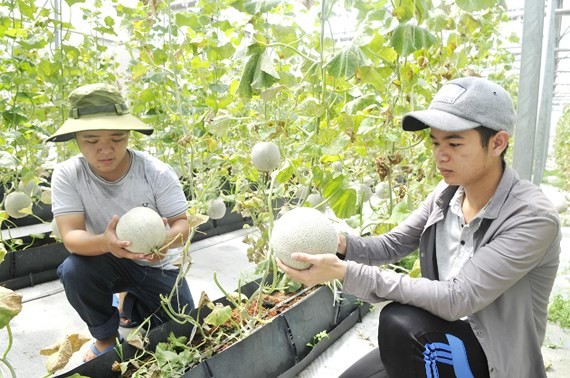
According to figures from the Ministry of Agriculture and Rural Development, total agro-forestry-aquatic export turnover was estimated at $16.1 billion in the first five months of this year, of which, exports of agricultural products were estimated at $7.7 billion, down 9.5 percent over the same period last year.
Not only did key export products see a slowdown but some agricultural products that are considered as Vietnamese specialties also faced poor consumption.
Mr. Nguyen Ngoc Trung, the owner of Gia Trung Durian Farm, the largest durian farm in Dak Nong Province with an area of nearly 70 hectares, said that in previous years when durians were ready for harvest, he usually sold his durians to firms which export durians to China, just a few of his durians was for domestic consumption. However, the situation is different this year. Not only durians but other farm products also have faced poor consumption due to several reasons.
Mr. Nguyen Tu, director of the Trade Promotion Agency of Dak Lak Province, said that because the prices of black pepper and coffee dropped drastically, farmers have switched to grow fruit trees, such as avocado, durian, mango and citrus. However, the sale of agricultural products of the province still encounters difficulties. Therefore, this year, the province concerns that it will possibly have to ‘rescue’ some kinds of fruits to help farmers.
Since the beginning of this year, many experts had said that this year would be a difficult year for production and consumption of agricultural products as global economic growth was forecasted to decline. Many countries in the world have returned to focus investing in agriculture so Vietnamese agricultural products will face cutthroat competition in export.
In addition, major import markets of Vietnam have increased protection on domestic products via standards on quality control, food safety and traceability. These have affected directly export of agro-forestry-aquatic products of Vietnam.
In China, one of largest import market of Vietnamese agro-forestry-aquatic products, several new technical barriers have been put up. For rice, since 2018, this country has raised import tariffs of glutinous rice from 5 percent to 50 percent and tightened import of broken rice at the same time.
Among 150 rice exporters, China only allows 20 of them to export rice to this market. As for vegetables and fruits, this country requires traceability and quality control. Exporters have to register growing area codes and make customs clearance at some certain border gates. These have caused several difficulties for export of vegetables and fruits.
Lately, the Ministry of Industry and Trade announced that some shipments of Vietnamese agro-forestry-aquatic products exported to the EU were rejected or supervised for not meeting food safety standards.
According to Mr. Truong Dinh Hoe, general secretary of the Vietnam Association of Seafood Exporters and Producers, the fact that China tightens control on food safety and orders firms to export officially is also an opportunity for Vietnamese seafood producers to promote official export to big cities of this country by sea.
It is high time that firms should not consider China as an easy market but need to invest seriously, improve product quality, carry out traceability and meet requirements of China about packing, labelling and bar code for exporting sustainably as well as increasing added-value of products.
Some experts also said that in order to speed up export of Vietnamese products, it is essential to improve the leading role of ministries through studies and surveys to understand the situation and changing tendency of the market so as to make policy and timely guide firms.
Firms should follow market demand to produce suitable products, instead of selling products that they have. Vietnamese firms should increase advertising and marketing and have a long-term vision to protect the prestige of the industry and Vietnamese products.
























